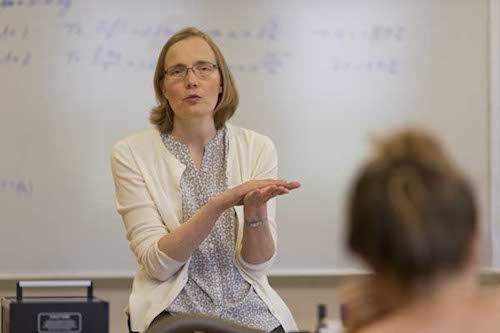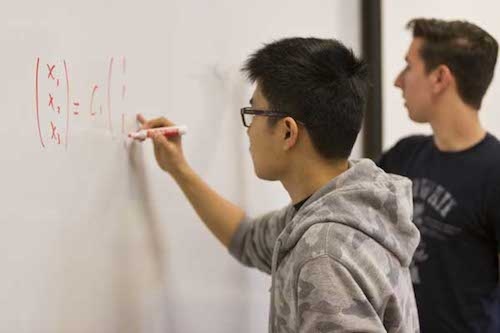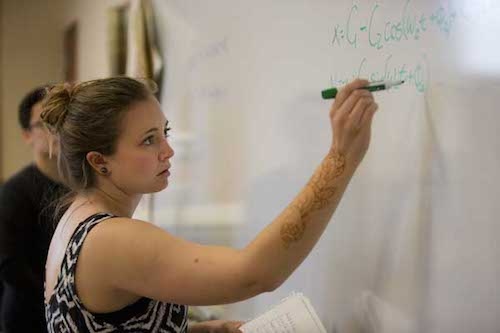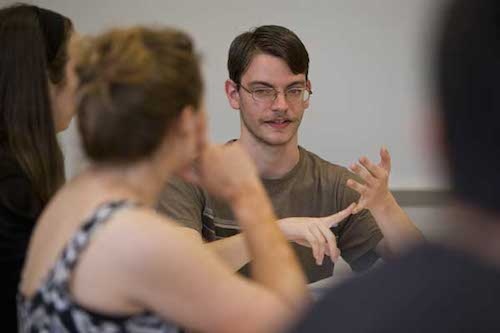Patrick Banner ’18 is a physics major from South Bloomfield, Ohio. Patrick is one of four sophomores awarded the 2016 prestigious Anderson Scholarship for Excellence in Science.
It’s an early April Friday afternoon in Physics 201. Our professor, Dr. Riina Tehver, walks into the classroom, glances over her students, and says “Glad to see that nobody is dead!” The comment receives tired but genuine laughter, and it’s indeed no small feat that nobody is dead—today is the due date of the Skyscraper Problem.
It begins with a simple prompt: “Imagine the top of a skyscraper. When the wind blows, it sways. Our job is to figure out how much.” From there, the problem asks you to conduct an eight-part symphony of mathematics and physical interpretation that includes a few motifs from class as well as many twists, turns, and moments of improvisation.
For me and my class of sophomore physics majors, this single problem has been hyped almost since day one. At the beginning of the academic year, I knew it was coming; at the beginning of the semester, I knew it was getting closer; and in the week or two before its arrival I anticipated it with vigor and terror.
This problem, created in large part by Physics Professor Steven Doty, has been given each year since 2007, and it has since become a “rite of passage” in the words of both Dr. Tehver and upper-level physics majors: we are not real physics majors, we have been told by upperclassmen, until we complete this single problem.
The problem is unique in many ways. The first three or four parts are relatively straightforward, but they are followed by a use of class material that requires you to split your brain between the big picture, in which you solve a fairly complicated differential equation, and the small details that allow you to subsequently interpret your results. On top of this, the later parts have a great degree of freedom and choice, and there’s rarely a single correct answer.
The problem “forces you to be okay with uncertainty… you have to, in some sense, put your own stake in the ground, follow your own logic, and get your own answers,” as Dr. Tehver noted.
The combination of creativity, physical intuition, and mathematical skill required means that the problem is physically and mentally exhausting: I was not alone when I spent some fifteen to twenty hours modeling the motion of the skyscraper over the course of four days, many of them in Olin the night before it was due, filling whiteboards with my own mathematical compositions.
In many ways, this is the kind of problem that physics majors at Denison are trained to handle. We are taught to be persevering and resilient, and spending hours in Olin at night filling up whiteboards is not completely new to us. We’re taught to be creative in finding the best way, rather than a correct way, to solve problems, and we are taught to think like true physicists.
We’ve been trained to use math as the language of physics, and this problem asks us “not only to create a sentence, or a paragraph, but to do natural philosophy” in that language, as Dr. Doty describes it. For this reason, the problem, in addition to being mentally fatiguing, is in no small part enjoyable.
“This is why I’m a physics major,” noted Amanda Nelson ’17. “The kind of problem solving that’s really involved and makes you really think is what I like best.” This is the kind of experience provided by the physics major, and by Denison in general: the flames of your academic passions will be made to burn brighter than ever before by critical thinking and challenge. It’s intense, sometimes fatiguing, sometimes almost unbearably stressful, but incredibly stimulating and rewarding.




